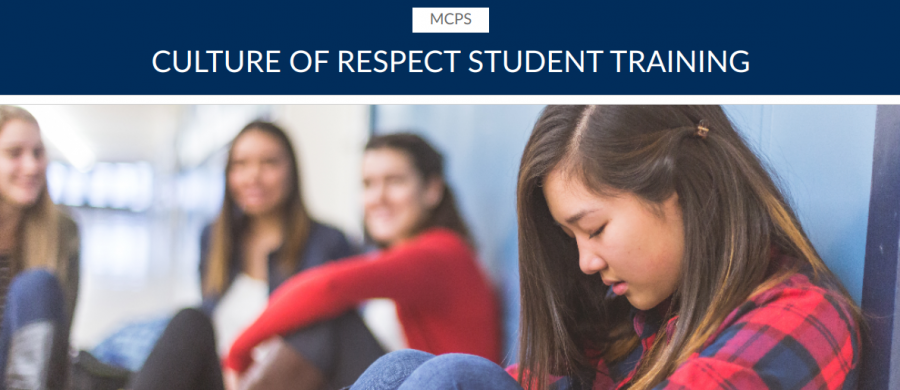Culture of Respect Training provides necessary information on how to recognize bullying and harassment
Photo by the Culture of Respect Canvas page
The homepage of the Canvas page for the Culture of Respect training. Students can access this training, which can earn them two Student Service Learning hours, by using Canvas.
December 14, 2020
In 2018, high school athletes at Damascus High School in Damascus, Md. were hazed and sexually assaulted, emphasizing the need for change and promotion of respect. The conclusion of the investigation led to the Culture of Respect Training, a program led by Montgomery County Public Schools to encourage and teach students about how they can create a culture of respect and report negative incidents in their schools.
The WilmerHale report, stemming from the name of the law firm investigating the incident at Damascus High School, was used by the school system to create changes to their systems. It called for student training on incidents relating to bullying, harassment and hazing.
“The Wilmer Hale report (Oct. 2019), recommended that MCPS provides students with knowledge and training on how to recognize and report incidents of bullying, intimidation, harassment, and hazing,” Greg Edmundson, the Director of the school system’s Student Welfare and Compliance Unit, said. “The decision was made to provide students with the content and reporting processes necessary to be safe in our schools and to continue to build on a culture the attributes to a positive learning environment within MCPS.”
Edmundson’s unit worked closely with the Montgomery County Board of Education. Brenda Wolff, the Board’s Vice President, was influential in ensuring the training would occur.
“It was recommended that Montgomery County Public Schools (MCPS) provides students with knowledge and training on how to recognize and report incidents of bullying, intimidation, harassment, and hazing,” Wolff said. “The decision was made to provide students with the content and reporting processes necessary to be safe in our schools.”
The training consists of a pre-assessment, the training itself and a post-assessment. The training, which can be found in students’ modules on Canvas, only takes about half an hour and walks students through different scenarios, provides them with definitions and shows videos.
The training is supposed to help students understand five key objectives: defining and giving examples of the terms, how students can report incidents, discuss potential consequences of the actions involved and review how students can help promote a positive environment at school. It is not mandatory but highly recommended.
“We wanted our students a) to have an incentive to complete the training and, b) to understand the connection between the training and the need to better serve the community through proper behavior and conduct amongst peers,” Edmundson said. “The training is structured in a way that will highly encourage all students in grades 6-12 to complete. Each school has been assigned a designee, responsible for supporting student completion and provide updates to school administration about completion rates.”
The training opened on Dec. 1 and students that complete it before Jan. 29 are eligible for two Student Service Learning hours. Students went over the training in advisory classes on Dec. 8.
This program has been in planning for years, with the school system wanting to do it. However, the WilmerHale report emphasized the need for it. While the racial and social justice protests this summer did not lead to this training, they underlined the importance of having it.
“We do believe in the rights of our students and the freedom to speak openly about their concerns,” Wolff said. “It is our hope that the content of this training leads to thoughtful conversations about systemic racism. Understanding what acceptable, respectful behavior looks like and how to report concerns of intimidation and discrimination greatly benefits our communities.”
The training was planned by multiple offices within the school system and external groups, including the Board of Education and the Student Welfare and Compliance Unit. Outside groups and parents also helped in the process.
This will not be the last time students have discussions on these important matters as this is just the school system’s first phase, as it works to create an environment free of discrimination.
“Although this training isn’t focused solely on race and inequality, the issue of discrimination isn’t acceptable within our school district,” Edmundson said. “The school district believes all students should see and hear themselves in our schools and classrooms and feel safe and supported throughout their learning experience.”


